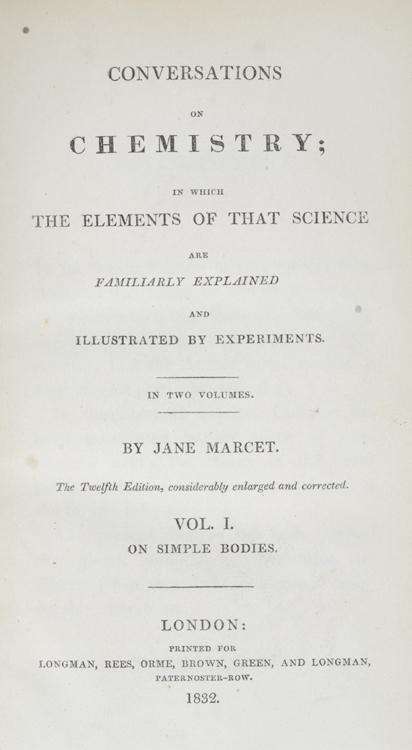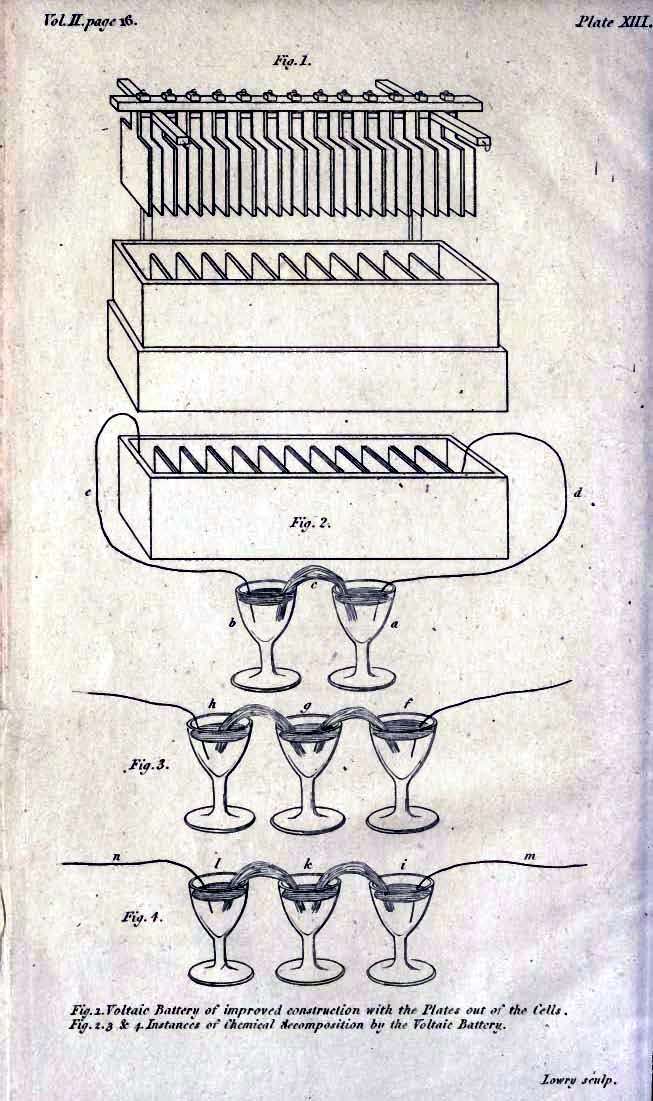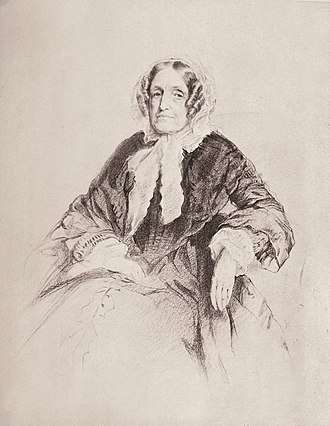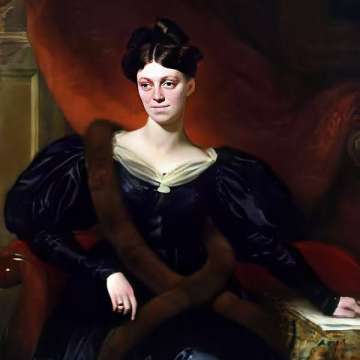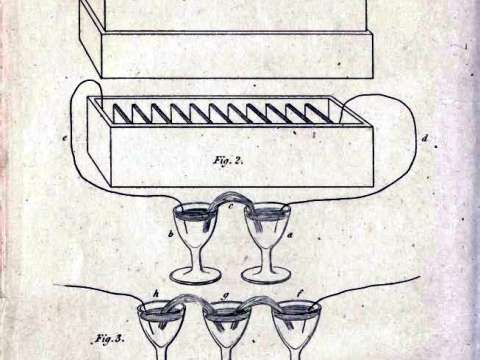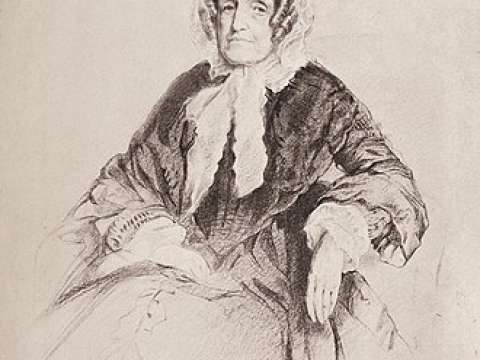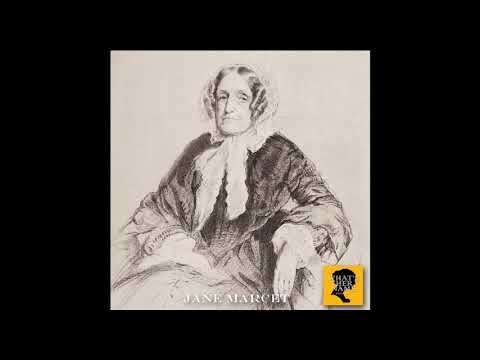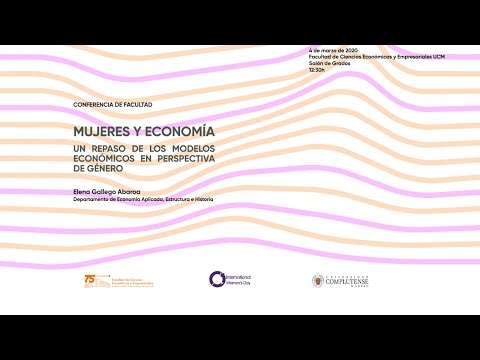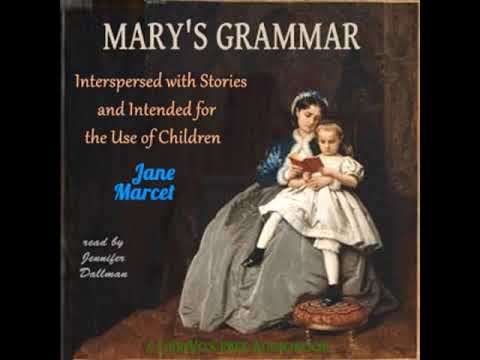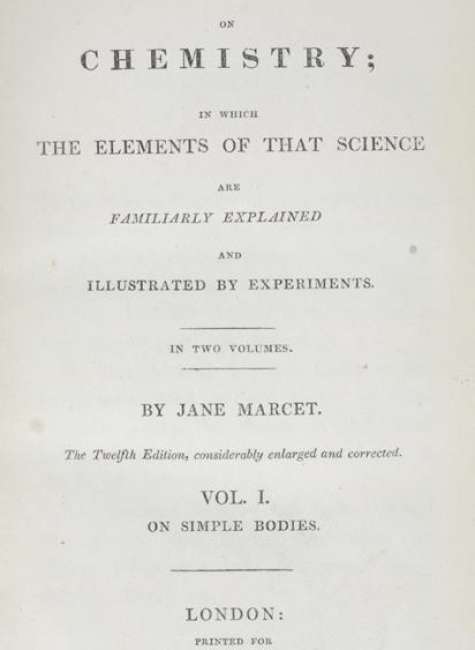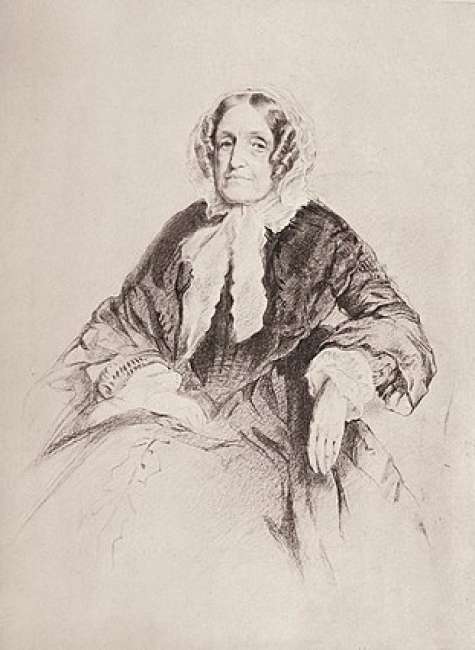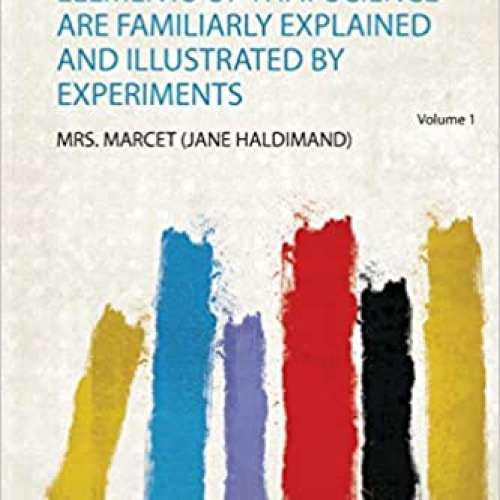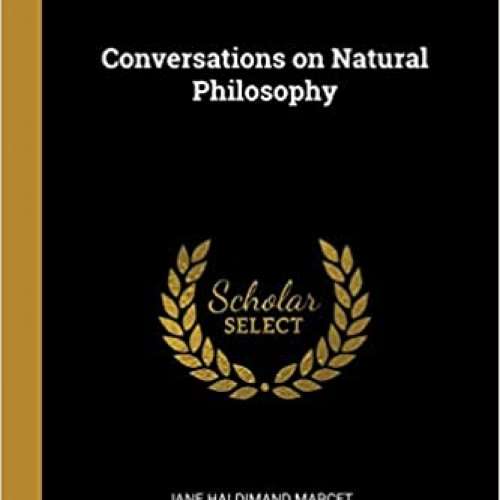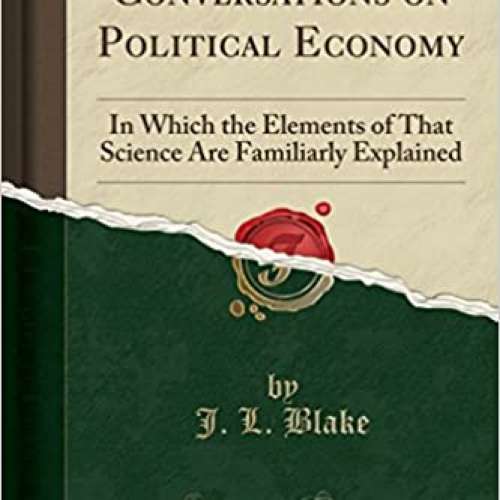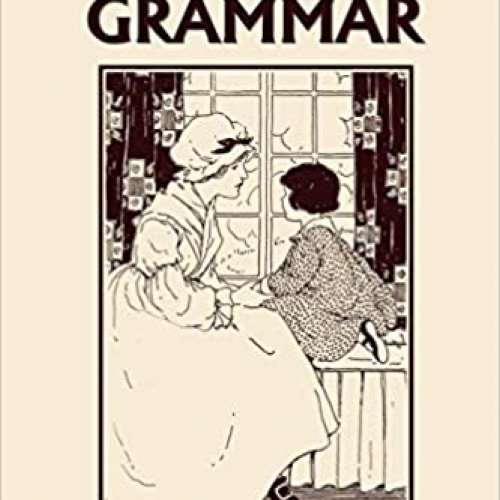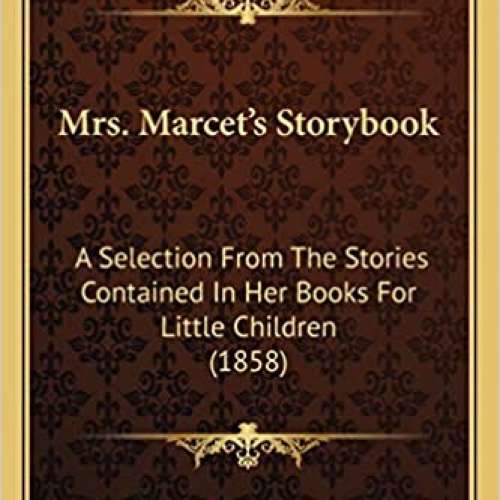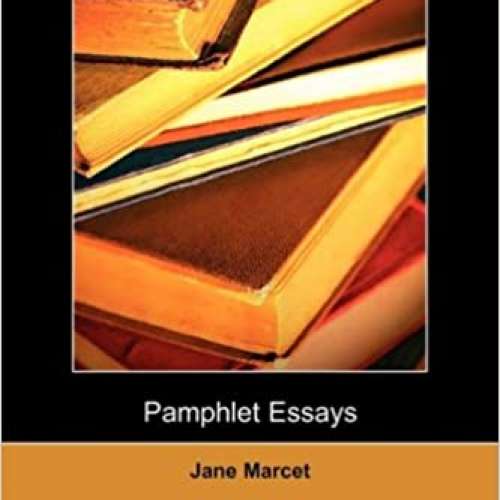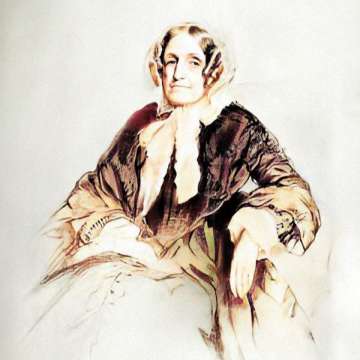

Jane Marcet (1769-1858)
Jane Marcet née Haldimand was an English salonnière of Swiss origin, and an innovative writer of popular, explanatory science books. She also broke new ground with Conversations on Political Economy 1816, which explains the ideas of Adam Smith, Malthus and David Ricardo.
Life
Jane Marcet was born in London on 1 January 1769, one of twelve children of a wealthy Genevan merchant and banker, Anthony Francis Haldimand 1740/41–1817, and his wife Jane died 1785. She was educated at home with her brothers. Her studies included Latin essential for the sciences, chemistry, biology and history, as well as topics more usual for young ladies in England. Jane took over the running of the family at age 15, after her mother's death. She managed the house and helped to bring up her younger siblings. Her younger brother William Haldimand 1784–1862 became a director of the Bank of England and a member of Parliament. She also acted as her father's hostess, helping to entertain frequent parties of scientific and literary guests. Jane developed an early interest in painting during a visit to Italy with her father in 1796, and studied with Joshua Reynolds and Thomas Lawrence. Her artistic training later enabled her to illustrate her books.
Jane was married in 1799 to Alexander John Gaspard Marcet 1770–1822, a political exile from Geneva, Switzerland who graduated from medical school at the University of Edinburgh as a physician in 1797. After their marriage, the Marcets continued to live in London. They had four children, one of whom, François Marcet 1803–1883, became a well-known physicist.
Alexander was strongly interested in chemistry, and became a lecturer at Guy's Hospital in London and a Fellow of the Royal Society. When Jane became interested in learning more about chemistry, they conducted experiments together in a home laboratory, discussing the scientific principles involved.
The Marcets were part of a literary and scientific social circle that included many leading writers and scientists such as Mary Somerville, Henry Hallam, Harriet Martineau, Auguste Arthur de la Rive and Maria Edgeworth. Novelist Maria Edgeworth described their home, with its lively, intelligent children and welcome for visitors, in her letters. One of Edgeworth's anecdotes gives a vivid picture of the Marcet family and its scientific and social activities:
"We came here last Friday, and have spent our time most happily with our excellent friend Mrs. Marcet. His children are all so fond of Dr. Marcet, we see that he is their companion and friend. They have all been happily busy in making a paper fire-balloon, sixteen feet in diameter, and thirty feet high. A large company were invited to see it mount."
Jane and her father were close throughout their lives, and he lived with his daughter and her husband after their marriage. After Jane's father died in 1817, she received a substantial legacy which enabled Alexander Marcet to devote himself full-time to chemistry, giving up his medical practice. Alexander, in his turn, understood and supported his wife's need for intellectual engagement and productive work.
"Conversations"
After helping to read the proofs of one of her husband's books, Marcet decided to write her own, and produced expository books on chemistry, botany, religion and economics under the general title "Conversations". In her prefaces, Marcet explicitly addresses issues of whether such knowledge is suitable for women, arguing against objections and stating that public opinion supports her position.
The first of these was written in 1805, although not published until 1819, as Conversations on Natural Philosophy. The textbook covered the basics of scientific knowledge of the time: physics, mechanics, astronomy, the properties of fluids, air, and optics. It established a common format in Marcet's works: a dialogue between two pupils, Caroline and Emily or Emilie, and their teacher, Mrs. Bryant Mrs. B. Caroline, the younger, asks flippant questions that nonetheless move the dialogue along, while Emily is more controlled and reflective. Mrs. Bryant is a maternal mentoring figure who leads them to question and examine their ideas. Both the scientific content of the dialogue, and the discursive process of sharing scientific knowledge, were important for Marcet's readers.
Marcet's next book, Conversations on Chemistry, Intended More Especially for the Female Sex was published anonymously in 1805, and became her most popular and famous work. Summarizing and popularising the work of Humphry Davy, whose lectures she attended, it was one of the first elementary science textbooks. It was accompanied by Marcet's drawings of chemical apparatus and stressed the importance of demonstration by experiment and of theoretical rigour. Jane Marcet was not explicitly identified as the author until the 12th edition appeared in 1832. The book went into 16 editions in England, where it was an early inspiration for the young Michael Faraday. It was widely plagiarised in America, appearing there in at least 23 editions.

Marcet also popularised the arguments of political economists like Adam Smith, Malthus, and above all David Ricardo, in her Conversations on Political Economy 1816. This was well received and widely read, although some later economists such as Alfred Marshall were dismissive, to the detriment of its later reputation, and Joseph Schumpeter derided it as "economics for schoolgirls". The purpose, however, was an important one that went beyond the lucrative supply of a niche market. Mrs B's flippant pupil, Caroline, says that she would have thought a woman could be excused ignorance of that topic. Mrs B replies tartly, "When you plead in favour of ignorance, there is a strong presumption that you are in the wrong." Marcet's Conversations on Political Economy were an inspiration to Harriet Martineau to introduce economic topics into her writings.
In 1820 the Marcets travelled to Geneva, Switzerland, intending to relocate there. In 1822, Alexander died unexpectedly while on a visit to Britain. Jane was extremely distressed by his death. She went through one of several periods of depression to affect her during her life, described by her friend Auguste de La Rive as a "shadow enveloping an energetic and active spirit". Though she retained strong ties to her Swiss friends, she eventually returned to England to live.
She continued to be active in scientific circles, and updated and published new editions of her major works throughout her life. Her last edition of "Conversations on Chemistry" appeared when she was eighty-four. In later life, Marcet wrote new works mainly for children, perhaps with her grandchildren in mind. Mary's Grammar 1835 became a classic.
Jane Marcet lived for the latter part of her life with a daughter, at 14 Stratton Street, Piccadilly, London. She died there on 28 June 1858.
Legacy
Marcet's major contribution was her work as an educator. Her works contained few original ideas, but were based on careful study of current theories and a voluminous ongoing correspondence with current scientists. Her works were noted for their precision, accuracy, and thoroughness. She presented science and economics in an informal way, but her simple introductions to often complex subjects were widely appreciated by adults as well as children. Perhaps most importantly, they reached women, including students in prominent women's seminaries, who had not been encouraged to explore the experimental sciences at that time.
Marcet was uniquely qualified to play the role of popularizer of chemistry and economics by her contacts with many of the greatest thinkers and scientists of her day. She deserves credit for widely popularizing the new fields of chemistry and political economy. By writing in English, and in a discursive style, she made scientific knowledge accessible not only to women but also to men who were not trained in the fundamental languages of a classical education, Latin and Greek. While her original intent was to educate women, she reached a much broader audience in line with enlightenment ideals, and laid claim to the natural sciences as a public endeavour.

When the Boston Girls' High and Normal School became the first school in America to teach science to women through laboratory experience, in 1865, Marcet's Conversations on Chemistry was the text they used.
When Henry James wrote The Turn of the Screw in 1898, Marcet's works were still standard textbooks. The governess refers offhandedly to a text being "as impersonal as Mrs. Marcet or nine-times-nine."
Intellectual legacy
One of the world's greatest scientists, revolutionizing both physics and chemistry, Michael Faraday, born in 1791, read the work of Jane. He was impressed by her work on chemistry and by this it helped him to find a new calling for science and later claimed that it had played a vital role in his career as a chemist.
Faraday described Jane as, “When I came to know Mrs. Marcet personally; how often I cast my thoughts backwards, delighting to connect the past and the present; how often, when sending a paper to her as a thank you offering, I thought of my first instructress.”
The book aimed at helping other people who were bewildered by chemistry. She explained better in a way to understand than other textbooks, but they were still scientifically accurate. It was a user-friendly book and the subjects were divided into two parts, each part with more than 300 pages. It highlights the conversations between an adult's teacher and two children. Marcet also added her own figures to explain more clearly to helping people understand chemistry in an easy way. In England, sixteen editions of the book Conversations on Chemistry were published until the 1830s with all-inclusive updates. She had influenced so much from her book all over the world. Girls and other people who were not wealthy were pursuing the subject, were able to get to along so well with it.
Marcet's actively support on the teaching of chemistry to beginners by experimental laboratory presenting was new was recognized by many. After the Civil War, laboratory instruction was becoming the norm in American schools. Despite competition from many of the other authors and various books, Jane Marcet's Conversations on Chemistry ruled in the female advancement of knowledge. The popularity of Marcet's book during the early 1900s suggests that there was increasing acceptance by American schools to include basic subjects of theoretical and experimental science in the education of female sex. The availability of education on scientific theories in the schools of women to set the platform for increasing women's engagements in science. She has inspired many of the greatest chemists, scientists and Mathematicians in history. Mary Somerville, born in 1790, the Mathematician after whom The University of Oxford’s first women's college was named, said of Jane Marcet: “No one at this time can duly estimate the importance of Mrs Marcet’s scientific works.”
The book was also very popular in the United States, in part due to the publishing of nearly two dozen derivative editions by John Lee Comstock and others. Because of the lack of international copyright laws, Marcet did not control or receive payment for these editions. After being used as a standard textbook in Britain and United States, her book was translated in German and French. In the United States, Boston's Girls' High School and Normal School became the first school to teach science to women through laboratory experience, in 1865, based on the text of Marcet's Conversations on Chemistry.
Jane was inspired by the work economists of David Ricardo, Adam Smith and many others. Marcet then wrote Conversations on Political Economy in 1816, which notably drew attention for the arguments based on some notable works of some famous economists. The book mainly targeted the general idea of economics with liberating and educating poor people with no discrimination in sex. The idea was to teach general notions of political economy with the distribution of the property, taxes, on the division of labour, on the capital, on the wages and population and on the condition of poor.
In Jane Marcet's letter to Pierre Prevost, she clearly stated that: "I can assure you that the greatest pleasure I derive from success is the hope of doing good by the propagation of useful truths amongst a class of people, who, excepting in a popular familiar form, would never have become acquainted with them."
The book was well accepted and became a popular read. Later some economists like Alfred Marshall showed indifference to her work, which damaged her reputation. Joseph Schumpeter mocked it as "economics for schoolgirls". The aim of her book was an important one that went beyond the moneymaking for small markets. It was intended to popularize the lessons of political economy for the self-improving working classes and school curricula. It attempted to simplify the economics for the fewer, privileged audience and educate younger people in the principle of economics by which markets are regulated, using simple tales. Marcet's Conversations on Political Economy inspired Harriet Martineau, a British social theorist and Whig writer often cited as the first female sociologist, to introduce economic topics into her writings. She was inspired by her to teach the principles of economics not by pressing them into a story, but by demonstrating their natural workings in selected phases of life. It followed a style resembling that of her previous book and likewise became popular.
Following the death of her father in 1817, Jane Marcet inherited considerable properties. She and her husband moved to Geneva in the 1820s; two years later Alexander died. Jane eventually settled back in London, where she again surrounded herself with prominent intellectuals and bankers. Her later works largely focused on less-demanding topics and were typically for a younger audience.
Further success came with the 1819 publication of Conversations on Natural Philosophy, which she had written before Conversations on Chemistry, to which she did not attach her name as author until 1832. Her other notable books in this period included Mary's Grammar 1835_.
Marcet's early anonymity left it open for male authors in the United States to supplement and issue their editions of Jane's work in their own invented language and place their names on the book's title page as authors. When Marcet published the 12th edition under her own name, it created a situation of chaos among the published books but nothing happened in the end. Owing to the lack of international copyright laws, Jane never received royalties for any editions published in the United States under the names of other authors.
While Marcet went on to publish several other popular works, including Conversations on Political Economy and Conversations on Plant Physiology, none of these became as widely read as Conversations on Chemistry.
With each successive edition, Marcet continued to update her book. She wrote to Michael Faraday in 1845, an esteemed writer and a member of the prestigious Royal Society, for detailed and expanded information on his research. He presented his latest breakthroughs to the woman who had first sent him on his chemical journey.
Scholarship and popularization
Jane Marcet spread knowledge by easing its creation, sharing and use. She created and maintained social and intellectual connections among scientists, elites, literary writers, economists and the larger public. She did not simply make knowledge created by others attractive. She worked on the boundaries of various objects of discussion, from which knowledge flowed in all directions. Those showing respect for her ideas on political economy included Thomas Robert Malthus and James Mill.
Willie Henderson tried to place Jane within the framework of an educational broker, arguing that to change the perspectives of others mind was "mere capitalist propaganda" for "sophisticated curriculum development".
For Jane, communication was not a one-way activity. It conveyed a message and made the public aware of the ideas of professionals, who in turn were provided with new challenges by her active role in facilitating the two-way communication. She brought a deep perception of classical economics to bear on social questions by counterposing the "prejudices and popular feeling of uninformed benevolence".
Furthermore, she introduced the insights of continental thinkers into the writings of the English classical school, so challenging them to decide what was peripheral and what central to the story. This included consolidating the ideas of bankers, political actors and business people as professional political economists.
Marcet always kept herself distant from people with central dogmas of classical economics, but kept the conversation going with the masters of them. She was tough about accepting criticism, but at other times kept her directions to herself. While teaching wisdom through professionals to the untaught public she also built up the networks that focused on her direct engagement to transmit the conversation to the people.
Marcet's Conversations on Political Economy appeared in 14 editions and was translated into Dutch, German and Spanish, and twice into French. It had a strong impact on young persons, on writers and popularizes like Harriet Martineau, Jean-Baptiste Say, Millicent Garrett Fawcett, on great political economists of the 19th century, such as Malthus, JS Mill and many more, and on politicians and bankers with whom she had social ties. This made her one of the great early 1900s popularizers of political economy, this information flow being central to her work. Historically, she rests between the great female-led continental salons of the 18th century and the professional knowledge brokers of the 20th. Marcet in the 19th century helped to define the field.
Jane Marcet lived for the rest of her life with her daughter, in Piccadilly, London. She died there on 28 June 1858 leaving a legacy of her works.
Publication
Jane Marcet's publications included:
- Conversations on Chemistry 1805
- Conversations on Political Economy 1816
- Conversations on Natural Philosophy 1820
- Mary's Grammar 1835
- John Hopkins's Notions on Political Economy 1833
- Mrs Marcet's Story-Book: Being a Selection from the Stories Contained in Her Books for Little Children 1858
- The seasons, stories for very young children, by the author of 'Conversations on chemistry' 1832
- Willy's Grammar – Scholar's Choice Edition
- Pamphlet Essays: Under the Superintendence of the Society for the Improvement of the Working Population in the County of Glamorgan
- Mrs Marcet's Story-Book – Scholar's Choice Edition
- Controlling State Crime
- Bertha's Visit to her Uncle in England. By Jane Marcet 1830
- Conversations on the History of England, for the Use of Children 1842
- Conversations on the Evidence of Christianity in Which the Leading Arguments of the Best Authors Are Arranged, Developed, and Connected with Each Other for the Use of Young Persons and Theological Students
- The Seasons; Stories for Very Young Children; Spring. Vol. II
- Conversations on Vegetable Physiology: Volume 1: Comprehending the Elements of Botany, with Their Application to Agriculture
- Lessons on Animals, Vegetables, and Minerals - Scholar's Choice Edition 2015

